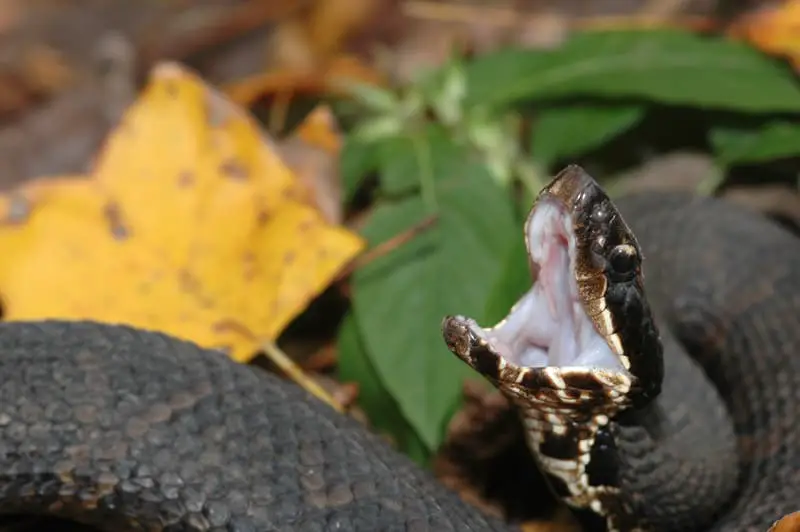There are 14 kinds of venomous snakes in the state of Texas. Ten of these are rattlesnakes. The others are the Northern cottonmouth, two subspecies of copperhead, and the Texas coral snake.
This article will list the venomous snake species in Texas and describe each snake. We’ll also talk about where you will likely find them in the state.
Copperhead Snakes
Taxonomical Changes to Coppehead Snakes in Texas
The Copperhead population in Texas was formerly divided into three subspecies. These were Southern, Broad banded, and Trans-Pecos Copperheads. However, after DNA analysis, scientists have rearranged the taxonomy of copperhead snakes. Texas is now left with two recognized copperhead subspecies. These are the Eastern copperhead and the Broadbanded copperhead.
There is little genetic difference between the Northern, Southern, and Osage Copperheads. Today, the three former subspecies are taxonomically combined. The common name for these snakes is Eastern Copperhead. Their scientific name is Agkistrodon contortrix. Source
Texas was formerly home to both Broad banded and Trans-Pecos Copperheads. However, DNA shows that there is little genetic difference between the two snakes. Therefore, the two subspecies were merged under the scientific name Agkistrodon contortrix laticinctus. Their common name is Broad-banded Copperhead. Furthermore, the Trans-Pecos sub-species is no longer taxonomically recognized. Source
Nevertheless, there are some phenotypical and geographic differences between the two snakes. For the purpose of this article, we will still recognize them as two separate entities.
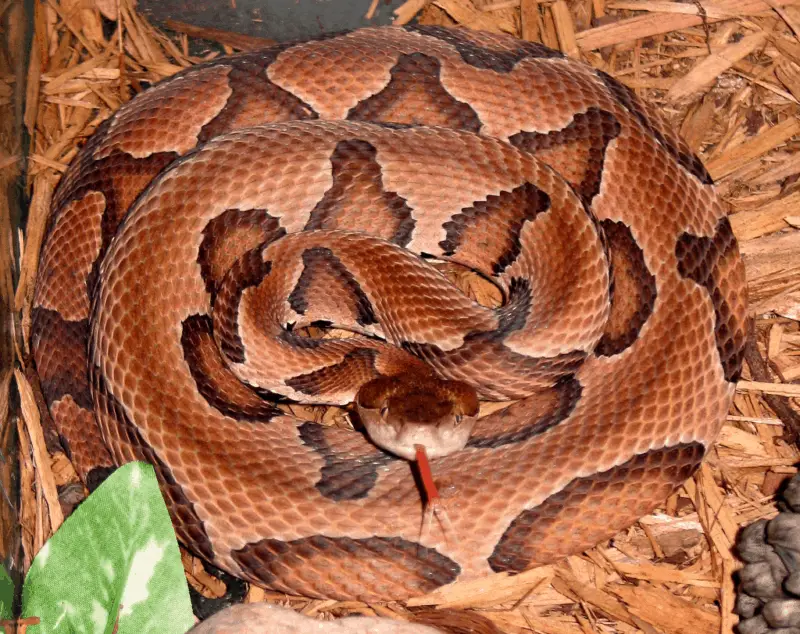
Eastern Copperhead
| Scientific Name: | Agkistrodon contortrix |
| Description: | Adult copperheads are 20 to 37 inches (50 to 95 cm) long. Their bodies are coppery brown overlayed with dark brown hourglass blotches. |
| Habitat: | Deciduous forests, river bottoms, and rocky wooded hillsides. |
| Conservation Status: | Common within their range. It is not protected and can be legally collected with a hunting license. |
The Eastern Copperhead is a pit viper native to the eastern United States.
Copperheads are stout heavy-bodied snakes. Adult copperheads are 20 to 37 inches (50 to 95 cm) long.
Eastern Copperhead snakes have reddish-tan to grayish-tan bodies. Their bodies are overlaid with hourglass-shaped dark brown markings. Their triangular heads are proportionately large. The color of their head is dark coppery brown. This is the reason they have the name “Copperhead.”
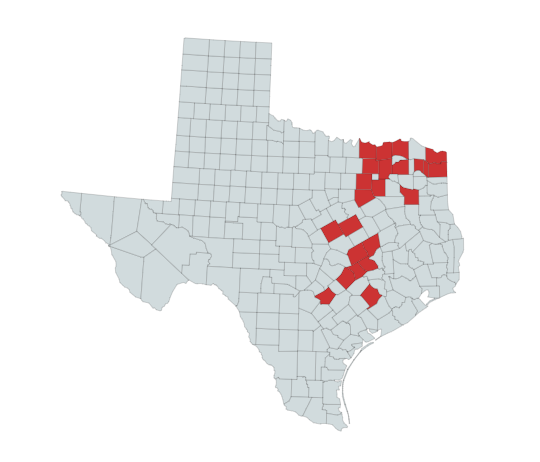
Where Do Eastern Copperheads Live in Texas?
You will find the Eastern copperhead throughout eastern Texas.
Look for them in lightly wooded areas. This includes deciduous forests, river bottoms, and rocky wooded hillsides. They utilize leaf litter, tall grass, and other plant debris for cover. They are also, at times, found in wooded suburbs.
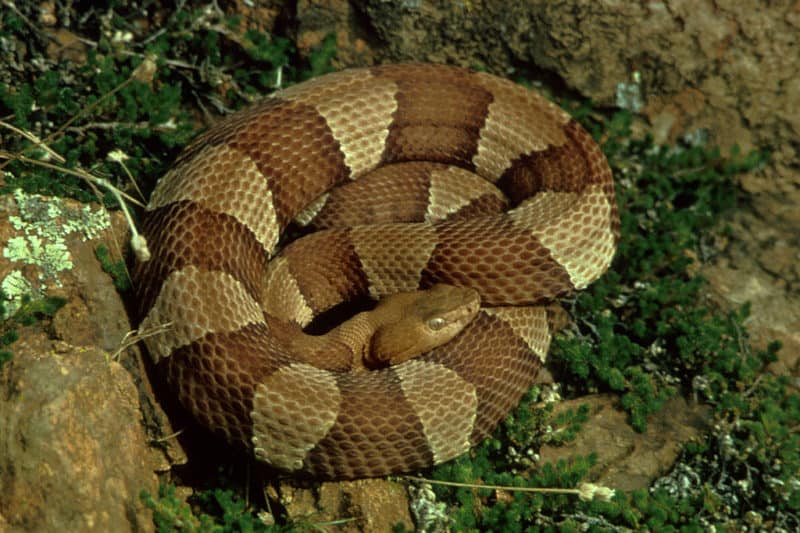
Broadbanded Copperhead
| Scientific Name: | Agkistrodon c. laticinctus |
| Description: | Adult copperheads are 20 to 36 inches (50–90 cm) long. Their bodies are coppery brown overlayed with broad brown bands. |
| Habitat: | Deciduous forests, river bottoms, and rocky wooded hillsides. |
| Conservation Status: | Common within their range. |
The Broadbanded Copperhead gets its name from the broad brown bands they have on a tan-based body. Their bands’ actual color varies from reddish-brown to grayish-brown. This depends on where they are located. Their underside is plain white and has minimal patterning. They measure from 20 to 36 inches (50–90 cm) long.
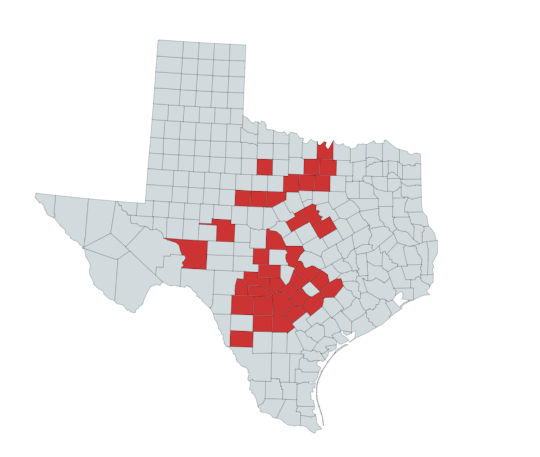
Where Do Broadbanded Copperheads Live in Texas?
You will find the Broadbanded Copperhead throughout central Texas. They are most prevalent in wooded areas close to a water source. They prefer areas where the leaf and plant debris offer them cover.

Trans-Pecos Copperhead (No longer recognized)
| Scientific Name: | Agkistrodon c. laticinctus |
| Description: | Adult copperheads are 20 to 36 inches (50–90 cm) long. Their bodies are coppery brown overlayed with broad brown bands. |
| Habitat: | Deciduous forests, river bottoms, and rocky wooded hillsides. |
| Conservation Status: | Common within their range. |
Trans Pecos Copperheads have tan bodies with brown bands. Their band color varies from a red-brown to a gray-brown depending on where they are located. As stated above, they are genetically Broadbanded Copperheads. Phenotypically, they are very similar. They do have some distinctions, though. One of which is the color pattern on the belly. The Trans-Pecos has an intricately patterned black and white underside. On the other hand, the Broad-banded has a white underside.
In size, these snakes grow to a length between 20 to 36 inches. (50–90 cm)

Where Do Trans-Pecos Copperheads Live in Texas?
Trans-Pecos Copperheads live in rocky and sparsely vegetated canyons of the Trans-Pecos region. This is in western Texas, between the Pecos River and the Rio Grande.
Copperhead Behavior
Copperheads are dangerous because they use camouflage as their number one defense mechanism. In other words, these snakes choose to lie perfectly still rather than flee most of the time. Their camouflage helps them blend in with leaf litter and other ground debris.
When they feel threatened, they occasionally mimic the tail vibration of a rattlesnake. But, in most cases, they choose to lie perfectly still.
Most copperhead bites on humans occur when the person steps on or near the snake.
Wintertime Brumation
Snakes do not tolerate the cold weather in the winter months very well. They are ectotherms, which means they can not regulate their body temperature internally. Physiologically, ectotherms cannot hibernate. Yet, they go into a state of suspended animation called brumation for up to 6 months out of the year.
Copperheads winter underneath rocks, in hollow logs, and in fissures on rocky hillsides. An individual might brumate alone in some parts of their range. But copperheads tend to be social. In some areas, they congregate together in dens with other snakes through the winter.
In hilly terrain, south-facing slopes capture more radiant warmth from the sun. So, that is where these dens are generally located. The other snakes they den with are not necessarily just copperheads. Sometimes, they share their dens with other species of snakes. You may find a Timber Rattler or a Black Rat Snake sharing the same den with copperheads. These wintertime dens may hold up to 60 snakes.
What Do Copperheads Eat?
Copperhead snakes are opportunistic feeders. They eat insects, spiders, frogs, small rodents, birds, and other reptiles.
How Dangerous Are Copperheads?
A Copperhead can bite and inject venom from the time they are newly born. Like most pit vipers, they have hemotoxic venom.
Most copperhead bites are not life-threatening. On the other hand, any bite from this snake is a medical emergency and should be treated as such. Prompt medical attention increases the chance of a good outcome.
Copperhead bites can cause intense pain, shock, and swelling. Their bites also have the potential to cause blood in urine, tissue damage, and kidney failure.
An interesting study has found that Copperhead venom contains a protein called contortrostatin. Contortrostatin has been found to stop the growth of cancer cells in mice.
Cottonmouth
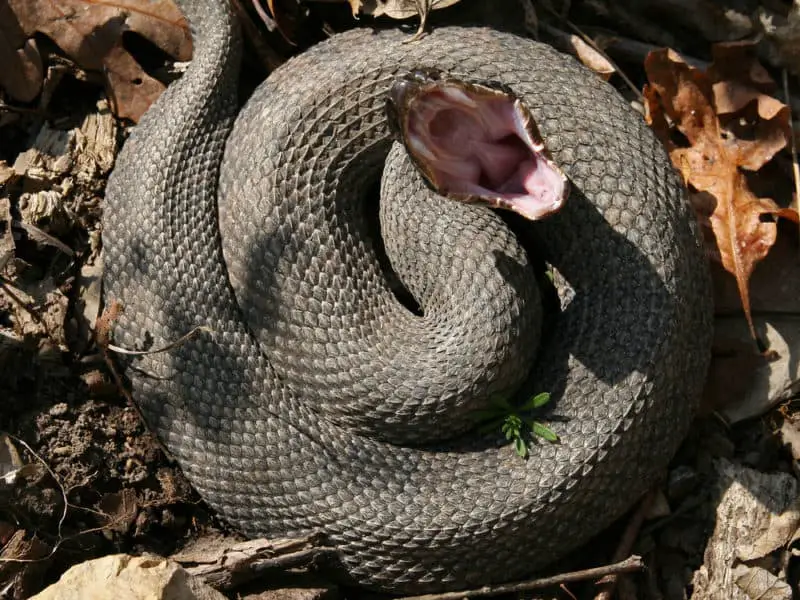
Northern Cottonmouth
| Scientific Name: | Agkistrodon piscivorus |
| Description: | Northern Cottonmouth snakes are stout, muscular snakes that grow up to 3 feet (.91m) long. They have a dark body with few markings. Their mouth is white. |
| Habitat: | They favor bodies of water like swamps, drainage ditches, slow-moving rivers, and lakes. |
| Conservation Status: | Common within their range in Texas. |
Another common name for the Northern Cottonmouth snake is the water moccasin. This stout, heavy-bodied snake grows up to 3 feet (.91m) long. They look a little bit like rattlesnakes without the rattle on the tail. People also sometimes mistake them for common water snakes. This could be a dangerous mistake.
The Northern Cottonmouth has a dark brown to black body with few markings. The inside of their mouth is white, hence the name “cottonmouth.” When threatened, they will pose with their mouth open. They have cat-like pupils, which appear as narrow slits in the day, and at night, they have a round appearance.
The juvenile cottonmouth has a more clearly defined pattern than adults. Their patterning resembles that of a copperhead snake. They have darker bands, though, that widen toward the belly and narrow at the back.
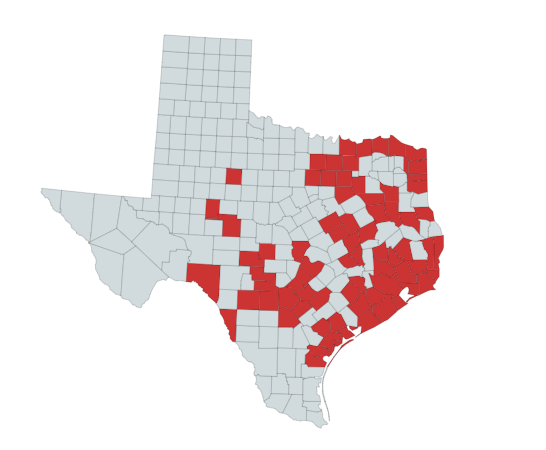
Where Do Northern Cottonmouths Live in Texas?
Cottonmouths are semi-aquatic snakes. They spend most of their time near swamps, marshes, rivers, and lakes. They can hold their breath underwater for up to an hour while hunting for prey. They are located in the eastern half of Texas.
What Do Northern Cottonmouths Eat?
These snakes prey on fish, freshwater crustaceans, amphibians, small mammals, and other reptiles. Cottonmouths sometimes congregate around drying wetland pools to feed on any trapped fish.
How Dangerous Are Northern Cottonmouths?
A Cottonmouth bite contains cytotoxic venom. This means it destroys body tissue. Northern Cottonmouth bites sometimes lead to the amputation of limbs. On rare occasions, death can occur. See
Rattlesnakes
The first thing people think about concerning rattlesnakes is their tails. When they are disturbed, they vibrate the rattles on their tails. This makes a buzzing or a rattling-type sound. Beware though. Sometimes, rattlers strike without rattling. Sometimes, their rattles fall off. You must be aware of where you are placing your hands and feet when you’re in rattlesnake country. If you hear a rattling noise, don’t move until you spot where it originated. Otherwise, you may accidentally move into the snake, prompting it to strike you.
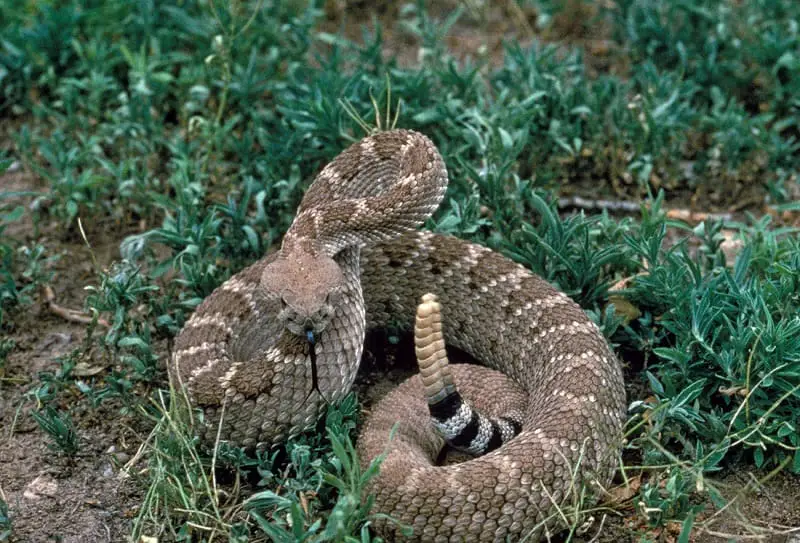
Western Diamondback Rattlesnake
| Scientific Name: | Crotalus atrox |
| Description: | Adults grow from 4 to 7 feet (1.22 to 2.13m) in length. They have diamond-shaped blotches along their back. |
| Habitat: | Their habitats include rocky canyons, plains, deserts, desert grasslands, and forests. |
| Conservation Status: | Common within their range in Texas. |
Western Diamondback rattlesnakes grow from 4 to 7 feet (1.22 to 2.13m) in length. Their base color varies. It can be yellow, light brown, salmon, gray, gray-brown, cream, or olive. They have dark diamond-shaped patterns along their backs. This is why they have the name “Diamondback.” The edges of their dorsal spots are darker than the centers. The centers are a bit darker than their base color. Their tails have two to eight black bands separated by pale gray bands. A dark line runs from the corner of the mouth to behind the eye.
This species has various names, including the Western Diamond-backed Rattlesnake and Adobe Snake.
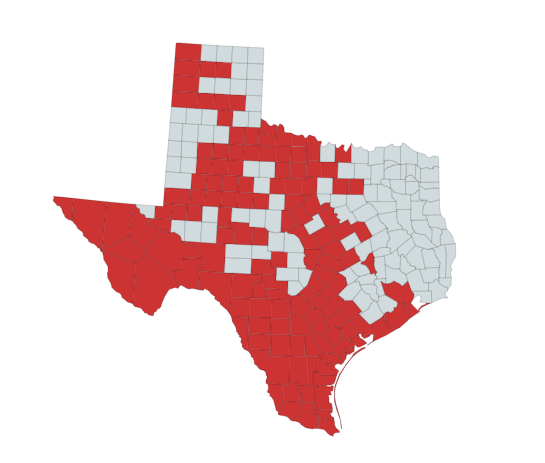
Where Do Western Diamondback Rattlesnakes Live in Texas?
Western Diamondback Rattlesnakes are the state of Texas’ most common venomous snakes. They inhabit the state’s western two-thirds. Their habitats include rocky canyons, plains, deserts, desert grasslands, and forests.
How Dangerous are Western Diamondback Rattlesnakes?
Western Diamondback Rattlesnake venom is Hemotoxic, cytotoxic, and myotoxic. If a Western Diamondback bite goes untreated, it can cause serious problems. These include severe internal bleeding and tissue damage, which might result in gangrene. Source

Timber Rattlesnake
| Scientific Name: | Crotalus horridus |
| Description: | Adult Timber Rattlesnakes grow between 36 and 60 inches (.91 to 1.52m) long. Their bodies are yellowish-brown with a dark chevron pattern. They also have a rusty stripe down their backs. Their tails are dark brown or black. |
| Habitat: | Timber Rattlesnakes prefer wooded areas and hillsides with rocky outcroppings. |
| Conservation status: | Threatened Species in Texas |
Timber Rattler and Canebrake Rattlesnake are both common names for the Timber Rattlesnake. Generally, in higher-elevation habitats, they are called Timber Rattlesnakes. In lowland areas, though, they’re called Canebrake Rattlesnakes.
The average adult grows from 36 to 60 inches (.91 to 1.52m) long. However, there have been reports of them growing up to 7 feet (2.13m) long. See
These snakes vary in color. Their general base coloration is a yellowish-brown to grey-brown, though. They have a dark brown to black chevron pattern on their back and sides against a lighter base color. Moreover, they have a rusty to reddish stripe down their backs. Their tails are dark brown or black. There are also melanistic timber rattlers. These are dark and sometimes almost entirely black. In the dark color morph of these snakes, the tail is also darker than the rest of the snake’s body.
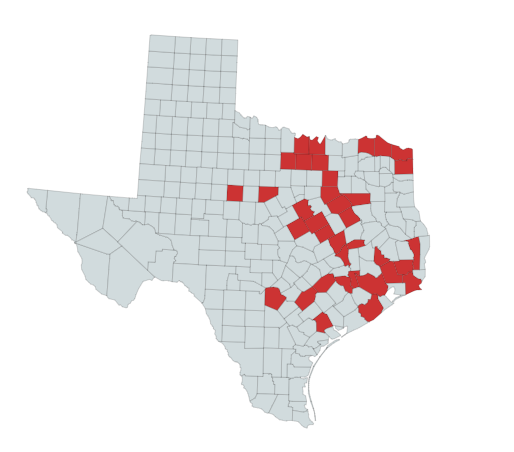
Where Do Timber Rattlesnakes Live in Texas?
Timber Rattlers live in various habitats. These include wooded areas, swamps, farm fields, and river floodplains. In Texas, they live in the southeastern part of the state.
What Do Timber Rattlesnakes Eat?
Timber rattlers prey on small mammals such as mice, rats, squirrels, and chipmunks. They also eat small birds, other reptiles, and amphibians.
These snakes are excellent climbers. In fact, timber rattlers have been found in trees at heights of more than 80 feet. Source
Experts have proven that timber rattlesnakes help control Lyme disease. This is because as they consume rodents, they’re also consuming ticks. A timber rattler will consume 2,500 to 4,500 ticks per year, depending on the location. See
Wintertime Brumation
Snakes do not tolerate the cold weather in the winter months very well. They are ectotherms, which means they can not regulate their body temperature internally. Physiologically, ectotherms cannot hibernate. Yet, they go into a state of suspended animation called brumation for up to 6 months out of the year.
Timber Rattlesnakes make wintertime dens in sheltered spots. They den underneath rocks and logs, as well as in fissures in rocky hillsides. An individual Timber Rattler might brumate alone in some parts of their range. But in other areas, they congregate in dens with other snakes through the winter.
Dens are usually placed on slopes facing south because they get more warmth from the sun. They don’t always share their dens only with Timber Rattlers. Sometimes, they share their dens with other species of snakes. These might include Copperheads and Texas Rat Snakes. These wintertime dens may hold up to 60 snakes.
How Dangerous Are Timber Rattlesnakes?
Timber Rattlesnakes are among the most dangerous in the United States. This is due to their long fangs and high venom yield. 1% to 10% of untreated Timber Rattlesnake bites result in a fatality.
Fortunately, 40% to 60% of the time, they produce dry bites. In other words, although their fangs penetrate the body, they do not inject any venom. Source
These snakes produce hemotoxic venom. Timber Rattlesnake bites sometimes cause serious complications. These include shock, seizures, coma, internal bleeding, and deep tissue damage. Source
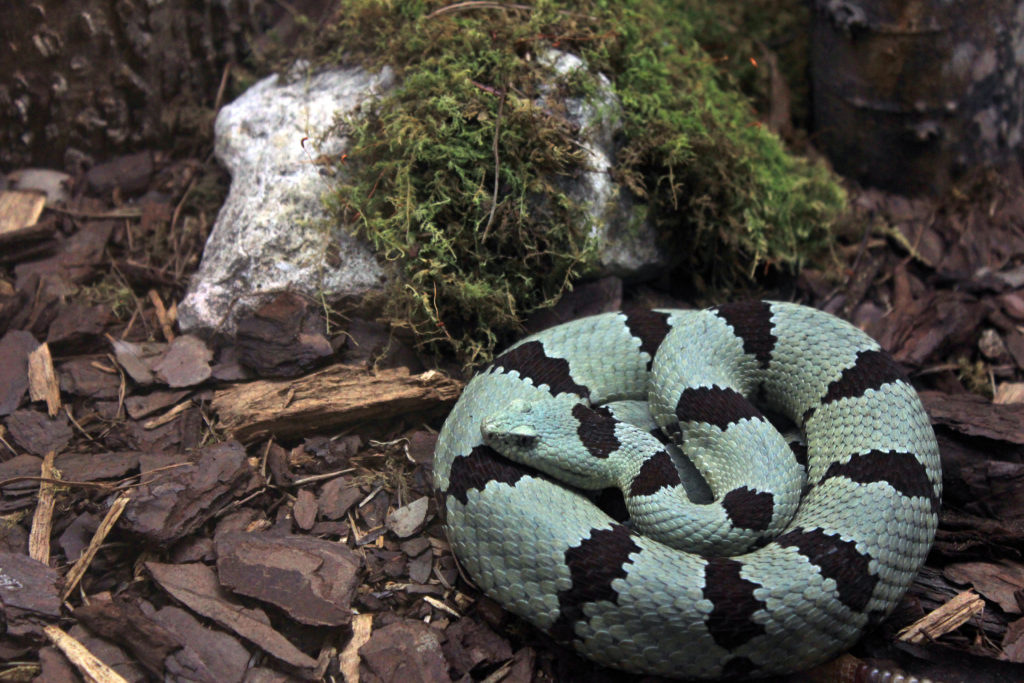
Banded Rock Rattlesnake
| Scientific Name: | Crotalus lepidus klauberi |
| Description: | Adults reach 24 to 33 inches (61 to 84cm) long. Blueish-gray to greenish-gray bodies with dark gray jagged crossbands. |
| Habitat: | They inhabit dry wooded stream beds and rock outcrops in creosote-cactus-covered terrain. |
| Conservation Status: | Common within their range. |
The Banded Rock rattlesnake is a smaller rattlesnake that measures 24 to 33 inches (61 to 84cm) long. This does not include its rattle. Their base color varies. It can be blueish-gray to greenish-gray. On top of their back are 14 to 24 dark gray to black jagged crossbands. They often have dark spots or flecks between the dark bands. A pinkish mottling is sometimes present on their underside. It becomes darker toward the tail. Their rattle is large compared to their body size.

Where Do Banded Rock Rattlesnakes Live in Texas?
Most of its range within Texas is the mountain ranges near El Paso.
As its name implies, the Banded Rock rattlesnake spends time in rocky terrain. They prefer steep talus slopes, stream beds, and rock outcroppings in evergreen forests. Source
How Dangerous Are Banded Rock Rattlesnakes?
A Banded Rock rattlesnake’s venom is hemotoxic. It can lead to various symptoms. It can cause significant pain and swelling at the bite site, making it uncomfortable. Nausea and vomiting might also occur. It can affect blood clotting and lead to excessive bleeding. It may also induce shock, leaving the victim feeling weak and disoriented. There’s also a possibility of mild paralysis. It’s crucial to seek immediate medical help if bitten by a Banded Rock rattlesnake. Source
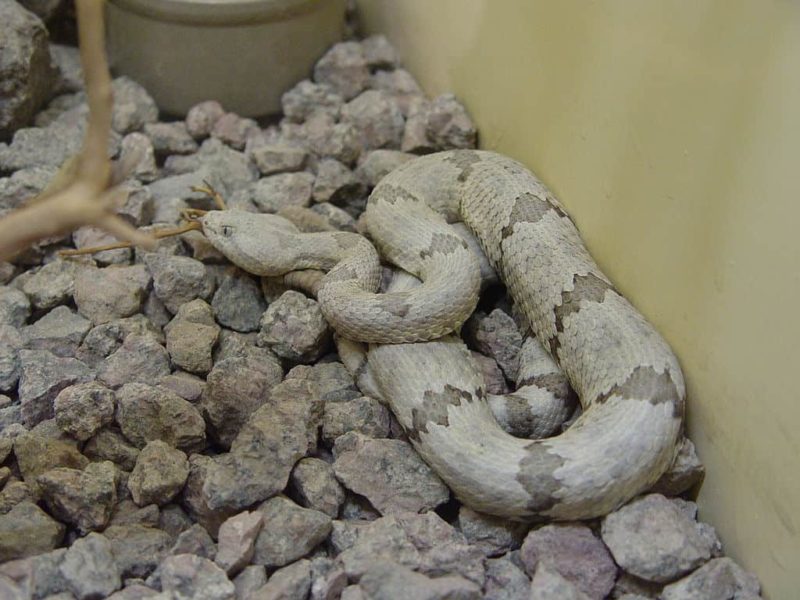
Mottled Rock Rattlesnake
| Scientific Name: | Crotalus lepidus |
| Description: | Adults reach 32 inches (81cm) in length. Their color pattern varies with the color of the rock in its environment. |
| Habitat: | They inhabit dry wooded stream beds and rock outcrops in creosote-cactus-covered terrain. |
| Conservation Status: | Common within their range. |
The Mottled Rock Rattlesnake is a smaller snake that rarely exceeds 32 inches (81cm) in length. Its color pattern varies with the color of the rock in its environment. Specimens that are found in limestone areas are a light gray color with darker gray bands. On the other hand, snakes found in higher altitudes are darker colored. Snakes in the Davis Mountains have a pink color, with dark gray speckles rather than banding.
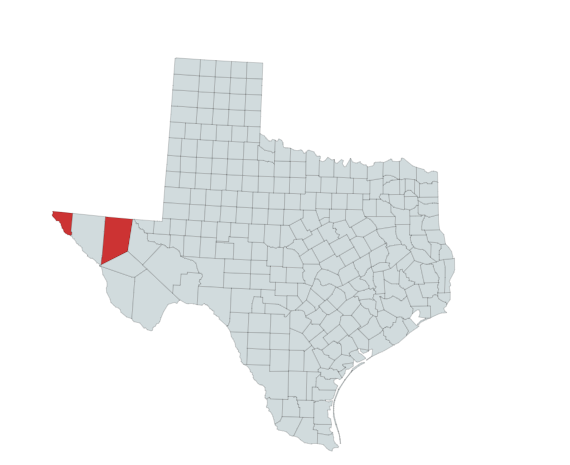
Where Do Mottled Rock Rattlesnakes Live in Texas?
These snakes are found in the southwestern part of the state of Texas.
How Dangerous Are Mottled Rock Rattlesnakes?
A Banded Rock rattlesnake’s venom is hemotoxic. It can lead to various symptoms. It can cause significant pain and swelling at the bite site, making it uncomfortable. Nausea and vomiting might also occur. It can affect blood clotting and lead to excessive bleeding. It may also induce shock, leaving the victim feeling weak and disoriented. There’s also a possibility of mild paralysis. It’s crucial to seek immediate medical help if bitten by a Banded Rock rattlesnake. Source

Northern Blacktail Rattlesnake
| Scientific Name: | Crotalus molossus molossus |
| Description: | 22 to 48 inches (56 to 122 cm) long. Gray to pale yellow with jagged dark blotches. Large triangular head. |
| Habitat: | They live in rocky mountainous areas and occasionally in the low desert. |
| Conservation Status: | Common within their range. |
Northern Black-tailed Rattlesnakes are also sometimes called Western Black-tailed Rattlesnakes.
Adult Northern Black-Tailed Rattlesnakes range from 22 to 48 inches (56 to 122 cm) long. Their triangular heads are proportionately large. Their base color varies. It may be gray, brown, yellowish brown, or pale yellow.
They also have jagged eight-sided black or brown blotches across their backs. These blotches have white interior spots. Towards the back of the snake, these blotches lose their jagged edges. At this point, they become crossbands. As their name suggests, these snakes have solid black or brown tails.

Where Do Northern Black-tailed Rattlesnakes Live in Texas?
The Northern Blacktail Rattlesnake is found in central Texas. They live in rocky mountainous areas and occasionally in the low desert.
How Dangerous Are Northern Black-tailed Rattlesnakes?
The venom of the Northern Blacktail Rattlesnake is hemotoxic. However, it is less toxic than the venom of some other rattlesnakes. For example, it is only two-thirds as toxic as the venom of the Western Diamondback. In general, it is not fatal to humans. They have larger venom glands than most rattlesnakes in the area. Because their venom is less toxic, they need to inject a large quantity into their prey to be effective. Source

Mojave Rattlesnake
| Scientific Name: | Crotalus scutulatus |
| Description: | Adult Mojave rattlesnakes are usually 2 to 4 feet long. They are brown, olive green, dark green, and tan. They have a distinct dark brown diamond pattern on their backs and a white belly. Their tails are marked with white and black bands. |
| Habitat: | Desert habitats. |
| Conservation Status: | Common within their range. |
Adult Mojave rattlesnakes typically measure 2 to 4 ft (about 0.61 to 1.22 m) in length. These snakes sport a base color that varies in shades of brown, olive green, dark green, and tan. Along their backs, they feature a distinctive dark brown diamond-like pattern. They have a white belly. Their tails are white and black banded. This adds to their unique appearance.
Other common names for this snake are Mojave Green Rattlesnake and Mohave Rattlesnake.
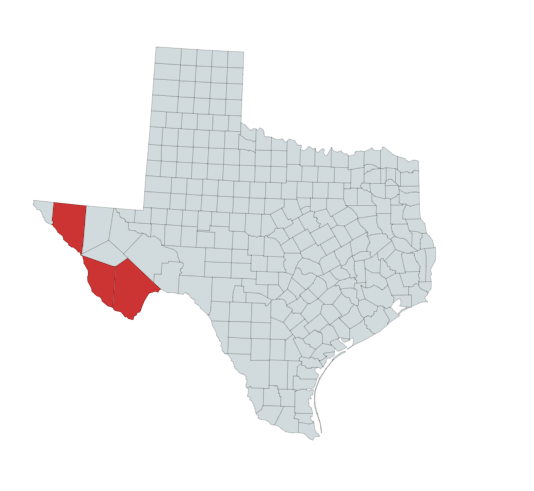
Where Do Mojave Rattlesnakes Live in Texas?
Mojave Rattlesnakes are found in far west Texas. They prefer high deserts (500 – 5,000 ft. elevation) and lower mountain slopes.
How Dangerous Are Mojave Rattlesnakes?
Mojave rattlesnakes have highly potent venom. They are one of the most dangerous snakes in the United States.
Their venom is either hemorrhagic/hemotoxic or neurotoxic. The type of venom the snake has depends on the area it lives in. Their hemorrhagic venom prevents blood clotting and destroys body tissue. On the other hand, their neurotoxic venom is even more dangerous. It shuts down the nervous system. Victims of neurotoxic venom may become paralyzed. Furthermore, they can lose the ability to breathe. Source
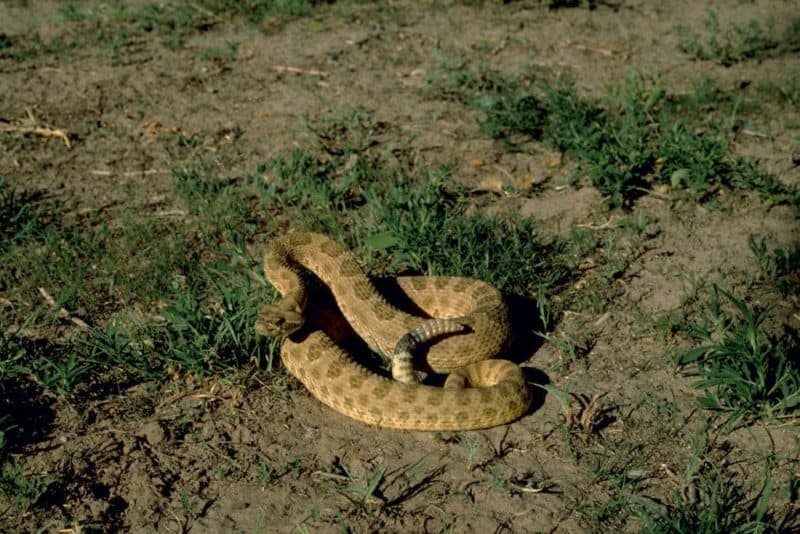
Prairie Rattlesnake
| Scientific Name: | Crotalus viridis |
| Description: | Adult Prairie Rattlesnakes average 3.3 feet (100 cm) in length. They are tan-colored with varying colors of brown blotches covering their bodies. |
| Habitat: | Look for Prairie rattlesnakes in open prairies, grasslands, and forested areas. |
| Conservation Status: | Common within their range. |
Adult Prairie rattlesnakes average around 3.3 feet (100 cm) in length. The longest recorded specimen measured just under 5 feet (151.5 cm) long. They are tan-colored with varying colors of brown blotches covering their bodies. They have a distinguishing triangle-shaped head with pit sensory organs on either side. A light stripe runs diagonally from the back of the eye to the jaw. Another strip runs diagonally from below the eye to the corner of the mouth. Prairie rattlesnakes are mostly ground snakes. But they occasionally climb into shrubs, bushes, or trees.
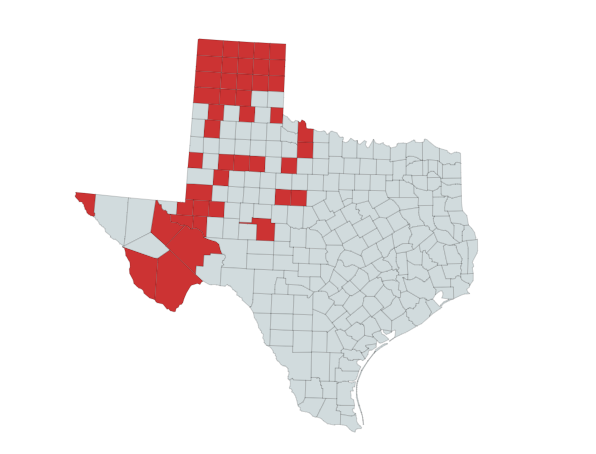
Where Do Prairie Rattlesnakes Live in Texas?
The Prairie Rattlesnake is most prevalent in the grassy plains of west Texas. They live in grassland deserts and pine-oak forests.
How Dangerous Are Prairie Rattlesnakes?
Prairie rattlesnake venom is a mix of hemotoxins and myotoxins. Furthermore, according to some literature, it also has neurotoxins.
Prairie rattlesnake bites can have serious effects. The venom can cause severe pain. It may also induce shock, making the victim feel weak and disoriented. Swelling, blistering, and inflammation can occur at the bite site. Their venom can also damage red blood cells and impair blood clotting. In severe cases, the bite may result in severe tissue damage. There is also a risk of harm to internal organs. Source
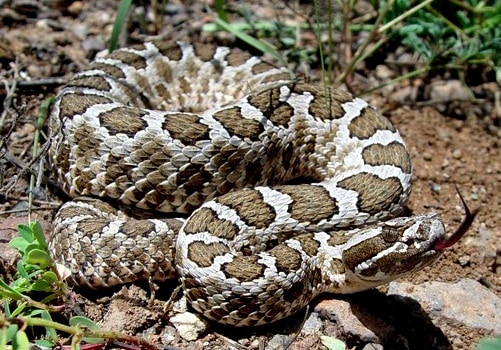
Desert Massasauga
| Scientific Name: | Sistrurus catenatus edwardsii |
| Description: | Adults reach 21 inches (53cm) in length. They are pale gray with dark brown blotches. A dark stripe that goes from the side of the head and across the eyes. |
| Habitat: | Semi-desert grassland habitats. |
| Conservation Status: | Common within their range. |
The Desert Massasauga is a smaller rattlesnake that reaches a length of 21 inches (53cm). They have a pale gray base with dark brown blotches. What’s more, they have a dark stripe that goes from the side of the head and across the eyes. These snakes are given the nickname “buzztale.” This is due to their high-pitched rattle sound. It’s distinctive from that of other rattlesnakes.
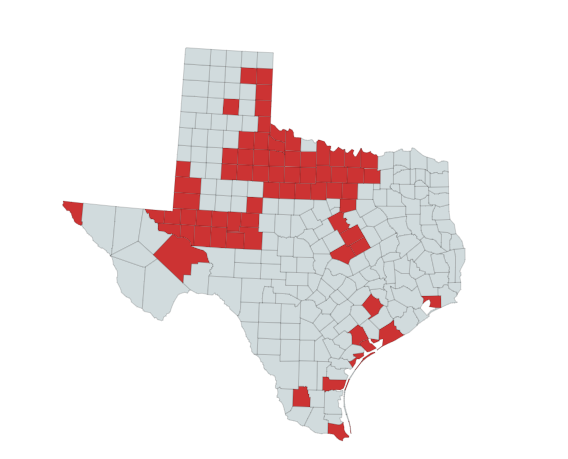
Where Do Desert Massasauga Rattlesnakes Live in Texas?
Desert Massasaugas inhabit the Trans-Pecos, western Panhandle, and the lower Rio Grande Valley. They live in semi-desert grassland habitats.
How Dangerous are Desert Massasauga Rattlesnakes?
The venom of the Massasauga rattlesnake is cytotoxic. Cytotoxic venom destroys body tissue. Moreover, digestive enzymes in cytotoxic venom disrupt blood flow and prevent clotting. Massasauga bites to humans are rare. However, they do occur.
There are two documented deaths in Ontario from Eastern Massasauga envenomations. In each of these cases, the victim did not receive antivenom in time. Source
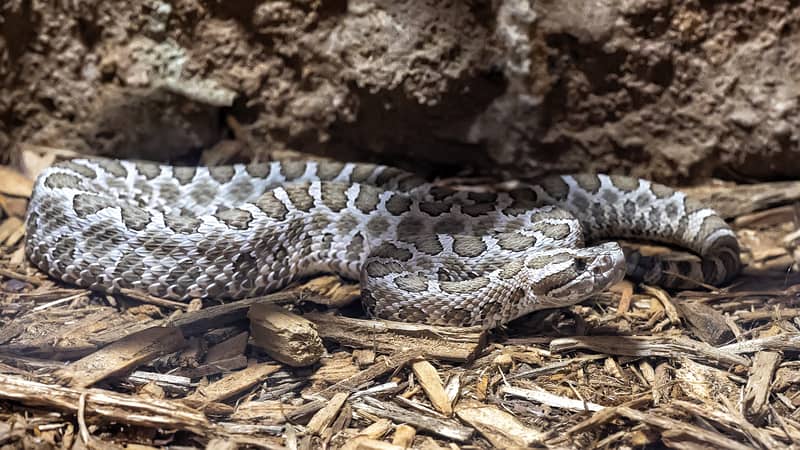
Western Massasauga
| Scientific Name: | Sistrurus tergeminus |
| Description: | Adult Western Massasaugas average 14 and 36 inches (36 and 91 cm) long. Their body is light grey with dark brown blotches. |
| Habitat: | Wet habitats such as swamps or marshy areas near lakes or streams. |
| Conservation Status: | Common within their range. |
Western Massasaugas are the smallest venomous snake in Missouri. Adults grow between 14 and 36 inches (36 and 91 cm) long. Their body is a light gray with dark brown blotches. They also have a dark stripe on each side of their face and across their eye.

Where Do Western Massasaugas Live in Texas?
Western massasaugas live in central Texas. They prefer wet prairies with grasses and sedges. They take refuge in crayfish burrows to escape predators and harsh weather.
How Dangerous Are Western Massasauga Rattlesnakes?
The venom of the Massasauga rattlesnake is cytotoxic. Cytotoxic venom destroys body tissue. Moreover, digestive enzymes in cytotoxic venom disrupt blood flow and prevent clotting. Massasauga bites to humans are rare. However, they do occur.
There are two documented deaths in Ontario from Eastern Massasauga envenomation. In each case, the victim did not receive antivenom in time. Source
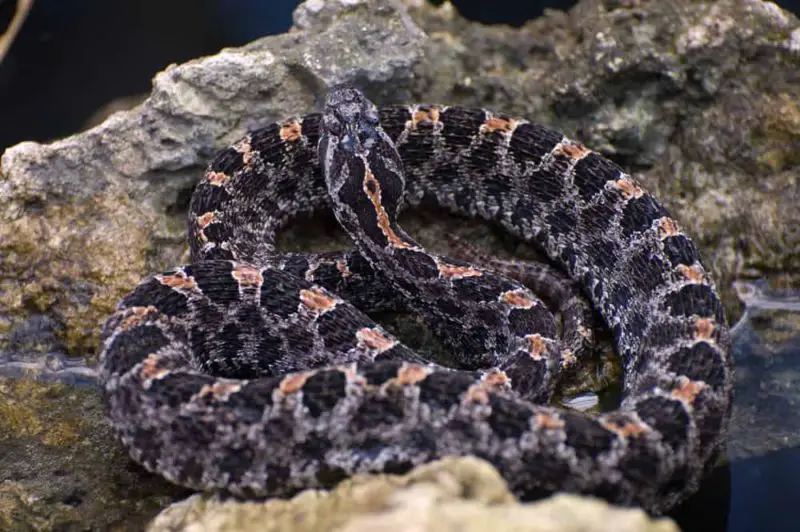
Western Pygmy Rattlesnake
| Scientific Name: | Sistrurus m. streckeri |
| Description: | Adult Western pygmies are 16 to 25 inches (.41 to .64m) long. Their bodies are light gray overlayed with dark blotches. A rust-colored stripe runs along its spine. |
| Habitat: | They inhabit sandhills, mixed forests, and floodplains. They also tend to be in close proximity to marshes, lakes, and other water sources. |
| Conservation Status: | Common within their range. |
The Western Pygmy Rattlesnake is a small, slender-tailed snake with a tiny rattle. It grows in length between 16 to 25 inches (.41 to .64m). The base color of its body is light gray. Furthermore, they have a rust-colored stripe along their spine. (The stripe may be absent in some individuals.) They also have a series of dark-colored blotches along their top and sides. Their cream-colored bellies are frequently mottled. They have a distinct, dark stripe that leads from the corner of their mouth to their eye. Their tiny rattle makes a faint grasshopper-like buzz that can only be heard from a yard away.
Other common names for this snake are ground rattlesnake and pygmy rattlesnake.

Where Do Western Pygmy Rattlesnakes Live in Texas?
Western Pygmy Rattlesnakes inhabit the sandhills, mixed forests, and floodplains of eastern Texas. They also live in habitats near marshes and lakes.
How Dangerous Are Western Pygmy Rattlesnakes?
Western Pygmy rattlesnakes have cytotoxic venom. By definition, cytotoxic venom destroys the body’s cells. This venom disrupts blood flow and prevents clotting with its digestive enzymes. Luckily, these snakes produce a small venom yield. A bite from a pygmy rattlesnake is unlikely to be fatal. However, any bite victim should still receive prompt medical attention.
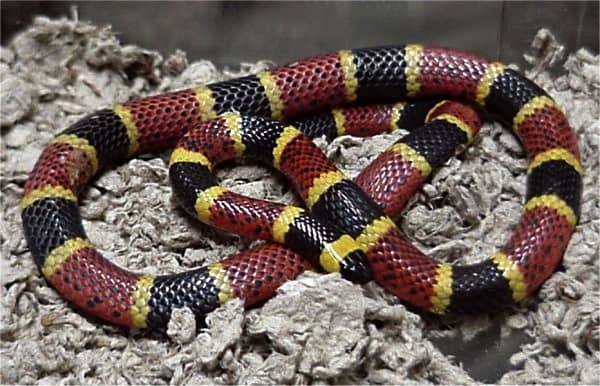
Texas Coral Snake
| Scientific Name: | Micruroides tener |
| Description: | 24 inches (61 cm) in length. Black, light yellow, and red bands, with the yellow bands separating the red and black. |
| Habitat: | Coral snakes prefer habitat below 6000 feet in elevation. They inhabit plains, arroyos, and dry river bottoms. They also live on rock and mesquite-covered slopes. |
| Conservation Status: | Common within their range. |
The Texas Coral Snake has the potential to grow up to 48″ long. However, average adult specimens of this species are around 24 inches (61 cm) long with a slender body. These are sexually dimorphic snakes. With the males being slightly smaller than the females. They have rounded heads and noses with similar-looking tails. It can be hard to tell a coral snake’s head from its tail because they are so similar. They are brightly colored, highly venomous snakes. They have black, light yellow, and red bands, with the yellow bands separating the red and black.

Where Do Texas Coral Snakes Live in Texas?
Coral snakes prefer habitat below 6000 feet in elevation. They inhabit plains, arroyos, and dry river bottoms. They also live on rock and mesquite-covered slopes.
Batesian Mimicry of Coral Snakes
Batesian mimicry is a biological term. It describes how a harmless species protects itself by resembling a dangerous one. For example, scarlet king snakes and milk snakes are non-venomous snakes. However, their color patterns closely resemble the venomous coral snake. The difference is that a coral snake’s red and yellow bands touch. On the other hand, the nonvenomous species’ color patterns are red, black, and yellow. Also, a coral snake’s head is blunt and entirely black, even behind its eyes, while a Kingsnake’s head is red.
This rhyme helps people distinguish between a nonvenomous species and a coral snake. “Red touch yellow can kill a fellow; Red touches black, a friend of Jack.”
The rhyme is mostly accurate in the United States. However, coral snakes from areas south of the U. S. do not always follow the black-yellow-red pattern.
Finally, there are rare coral snakes that do not follow the usual color pattern in the United States. Pink, cream-colored, light blue, and completely black coral snakes exist in the wild.
Texas Coral Snake Behavior
Texas Coral snakes are underground snakes. They spend most of their time buried in the sand, under leaf piles, and in rotten logs.
Defensive Farting
When rattlesnakes are uptight, they rattle their tails. On the other hand, coral snakes react to stress a bit differently.
When coral snakes are agitated, they fart. To do this, they draw air into their cloacas and force it out again. This makes a popping sound. Source
How Dangerous Are Texas Coral Snakes?
Coral snakes have neurotoxic venom. It is the second most potent snake venom in the world. (The mamba being the most venomous).
However, they are considered less dangerous than rattlesnakes. The reason is that they have a less effective venom delivery system. Their smaller mouth and fangs produce less venom. Yet, a coral snake bite should be taken seriously, and medical treatment should be sought. Sometimes, the manifestation of a severe bite doesn’t present itself for 24 hours.
People should take coral snake bites seriously, though. Before we had antivenom, the death rate after coral snake envenomation was around 10%. See
Potential effects of coral snake envenomation include,
- muscle weakness
- difficulty speaking
- difficulty swallowing
- difficulty breathing
- Inability to move eyelids
- blurred vision
- twitching of the tongue
- paralysis
- respiratory arrest
One reported death has been caused by an Eastern Coral Snake bite in the last 40 years. Source
Some of Texas’ venomous snakes pose a potential danger to humans. That fact should be taken with some perspective, though. Texas Parks and Wildlife statistics reveal the following. Lightning strikes in Texas kill 6 times more people than venomous snakebites.
Symptoms of Venomous Snake Bites
Some of the symptoms you may experience when a venomous snake bites you include:
- Discoloration in the area of the bite.
- Swelling in the area of the bite.
- Loss of muscle coordination.
- Tingling sensation in the area of the bite.
- Feeling nauseous.
- Having a faster heartbeat or rapid pulse.
What Should You Do if You Are Bitten?
If you or someone you are with has suffered a venomous snakebite, time is of the essence. Because the sooner a victim receives antivenom, the less chance the venom in their body has to cause harm. In other words, it is important to seek immediate medical attention.
Do not attempt to kill the snake for identification purposes. This gives the snake a chance to bite you again. Also, consider that severed snakeheads can still bite and envenomate and often do. If you have a phone, take a picture of the offending reptile. Otherwise, get started on your way to the nearest hospital.
First Aid for Snake Bite Victims
- Remain calm and limit your movements. Do not run. If you must hike back to a vehicle, do it calmly and deliberately. Put as little stress on your heart as possible.
- Keep the area of the snake bite below the heart level and never above the heart level. Keeping the bite below the heart level will reduce the venom’s flow. However, holding the bite above your heart level will increase the venom’s flow.
- Remove all constricting items such as bracelets, watches, or rings before swelling occurs.
- Remember that using a cold compress on a venomous snake bite is not advisable. The cold may cause the local blood vessels to constrict and spread the venom faster.
- You can wash the affected area like any other wound with soap and water.
- You may cover the bite area with a moist dressing to reduce the swelling.
- Get medical attention as soon as possible. Call the hospital to tell them a venomous snake has bitten you. So they can have antivenom ready to give you when you arrive.
- A person whom a venomous snake has bitten may go into shock. If this happens, lay them flat and cover them with a blanket.
Dressing for Snake Country
- High-top leather boots and long pants are both wise ideas.
- Also, wear loose-fitting denim. If there’s a gap before the snake’s fangs touch your skin, your chances of being envenomated are lower.
- In the absence of high-top leather boots, some people wear snake gaiters.
You might also like:
Recent Posts
The only venomous snakes in Washington State are Northern Pacific Rattlesnakes. The Northern Pacific Rattlesnake (Crotalus oreganus oreganus) is a sub-species of the Western Rattlesnake. Anyone...
Skunks are not classified as true hibernators. But they go into a state of torpor when the weather gets cold. Skunks are light sleep hibernators, along with opossums, bears, and raccoons. ...

